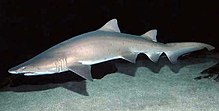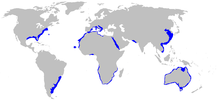Spotted ragged-tooth shark
| Sand tiger shark | |
|---|---|
 |
|
| Scientific classification | |
| Kingdom: | Animalia |
| Phylum: | Chordata |
| Class: | Chondrichthyes |
| Order: | Lamniformes |
| Family: | Odontaspididae |
| Genus: | Carcharias |
| Species: | C. taurus |
| Binomial name | |
|
Carcharias taurus Rafinesque, 1810 |
|
 |
|
| Range of the sand tiger shark | |
| Synonyms | |
|
Carcharias tricuspidatus Day, 1878 |
|
Carcharias tricuspidatus Day, 1878
The sand tiger shark (Carcharias taurus), grey nurse shark, spotted ragged-tooth shark, or blue-nurse sand tiger is a species of shark that inhabits subtropical and temperate waters worldwide. It inhabits the continental shelf, from sandy shorelines (hence the name sand tiger shark) and submerged reefs to a depth of around 191 m (627 ft). They dwell in the waters of Japan, Australia, South Africa, the Mediterranean and the east coasts of North and South America. Despite its name, it is not related to the tiger shark Galeocerdo cuvier; however, it is a cousin of the great white shark Carcharodon carcharias.
Despite its fearsome appearance and strong swimming ability, it is a relatively placid and slow-moving shark with no confirmed human fatalities. This species has a sharp, pointy head, and a bulky body. The sand tiger's length can reach 3.2 m (10.5 ft). They are grey with reddish-brown spots on their backs. Shivers (groups) have been observed to hunt large schools of fish. Their diet consists of bony fish, crustaceans, squid, skates and other sharks. Unlike other sharks, the sand tiger can gulp air from the surface, allowing it to be suspended in the water column with minimal effort. During pregnancy, the most developed embryo will feed on its siblings, a reproductive strategy known as intrauterine cannibalism i.e. "embryophagy" or, more colorfully, adelphophagy — literally "eating one's brother". The sand tiger is categorized as vulnerable on the International Union for Conservation of Nature Red List. It is the most widely kept large shark in public aquariums owing to its tolerance for captivity.
The sand tiger shark's description as Carcharias taurus by Constantine Rafinesque came from a specimen caught off the coast of Sicily. Carcharias taurus means "bull shark". This taxonomic classification has been long disputed. Twenty-seven years after Rafinesque's original description the German biologists Müller and Henle changed the genus name from C. taurus to Triglochis taurus. The following year, Swiss-American naturalist Jean Louis Rodolphe Agassiz reclassified the shark as Odontaspis cuspidata based on examples of fossilized teeth. Agassiz's name was used until 1961 when three palaeontologists and ichthyologists, W. Tucker, E. I. White, and N. B. Marshall, requested that the shark be returned to the genus Carcharias. This request was rejected and Odontaspis was approved by the International Code of Zoological Nomenclature (ICZN). When experts concluded that taurus belongs after Odontaspis, the name was changed to Odontaspis taurus. In 1977, Compagno and Follet challenged the Odontaspis taurus name and substituted Eugomphodus, a somewhat unknown classification, for Odontaspis. Many taxonomists questioned his change, arguing that there was no significant difference between Odontaspis and Carcharias. After changing the name to Eugomphodus taurus, Compagno successfully advocated in establishing the shark's current scientific name as Carcharias taurus. The ICZN approved this name, and today it is used among biologists.
...
Wikipedia

